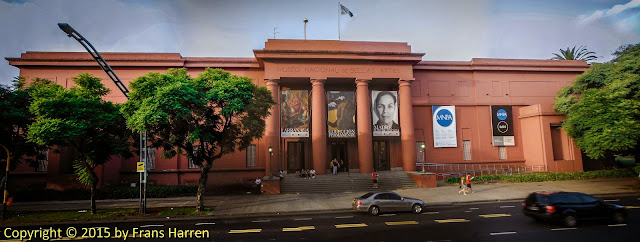
Museo Nacional de Bellas Artes (MNBA)
The National Museum of Fine Arts is an Argentine art museum in Buenos Aires, located in the Recoleta section of the city.
History
Argentine painter and art critic Eduardo Schiaffino was the first director of the MNBA, which opened on 25 December 1895 in a building on Florida Street which today houses the Galerías Pacífico shopping mall. In 1909 the museum moved to a building in Plaza San Martín, originally erected in Paris as the Argentine Pavilion for the 1889 Paris exhibition, and later dismantled and brought to Buenos Aires. In its new home the museum became part of the International Centenary Exhibition held in Buenos Aires in 1910. Following the demolition of the Pavilion in 1932 as part of the remodelling of Plaza San Martín, the museum was transferred to its present location in 1933, a building originally constructed in 1870 as a drainage pumping station and adapted to its current use by architect Alejandro Bustillo.
The museum was modernized both physically and in its collections during the 1955–64 tenure of director Jorge Romero Brest. A temporary exhibits pavilion was opened in 1961, and the museum acquired a large volume of modern art though its collaboration with the Torcuato di Tella Institute, a leading promoter of local, avant-garde artists, and elsewhere; a Contemporary Argentine Art pavilion was later opened in 1980. This 1,536 square metres hall is the largest of 34 currently in use at the museum, which totals 4,610 square metres of exhibit space. Its permanent collection totals 688 major works and over 12,000 sketches, fragments, potteries and other minor works. The institution also maintains a specialized library, totalling 150,000 volumes, as well as a public auditorium.
The ground floor of the museum holds 24 exhibit halls housing a fine international collection of paintings from the Middle Ages up to the 20th century, together with the museum's art history library. The first floor's 8 exhibit halls contain a collection of paintings by some of the most important 20th-century Argentine painters, including Antonio Berni, Ernesto de la Cárcova, Benito Quinquela Martín, Eduardo Sívori, Alfredo Guttero, Raquel Forner, Xul Solar and Lino Enea Spilimbergo. The second floor's two halls, completed in 1984, hold an exhibition of photographs and two sculpture terraces, as well as most of the institution's administrative and technical departments.
Buenos Aires
Buenos Aires is the capital and largest city of Argentina, and the second-largest metropolitan area in South America, after Greater São Paulo. It is located on the western shore of the estuary of the Río de la Plata, on the continent's southeastern coast. The Greater Buenos Aires conurbation, which also includes several Buenos Aires Province districts, constitutes the third-largest conurbation in Latin America, with a population of around fifteen and a half million.
The city of Buenos Aires is neither part of Buenos Aires Province nor the Province's capital; rather, it is an autonomous district. In 1880, after decades of political infighting, Buenos Aires was federalised and removed from Buenos Aires Province. The city limits were enlarged to include the towns of Belgrano and Flores; both are now neighborhoods of the city. The 1994 constitutional amendment granted the city autonomy, hence its formal name: Ciudad Autónoma de Buenos Aires (Autonomous City of Buenos Aires). Its citizens first elected a Chief of Government (i.e. Mayor) in 1996; before, the Mayor was directly appointed by the President of the Republic.
Buenos Aires is, along with Mexico City and São Paulo, one of the three Latin American cities considered an 'alpha city' by the study GaWC5. Buenos Aires, Argentina has the third best quality of life of Latin American cities. Buenos Aires' quality of life is ranked 81st in the world, with its per capita income among the three highest in the region. It is the most visited city in South America (ahead of Rio de Janeiro) and the second most visited city across Spanish Latin America (behind Mexico City). It is also one of the most important, largest and most populous of South American capitals, often referred to as the Paris of South America.
Buenos Aires is a top tourist destination, and is known for its European-style architecture and rich cultural life, with the highest concentration of theatres in the world. Buenos Aires held the 1st Pan American Games in 1951 and the city also had two venues in the 1978 FIFA World Cup. Buenos Aires will host the 2018 Summer Youth Olympics.
People from Buenos Aires are referred to as porteños (people of the port). The city is the birthplace of pope Francis (former Archbishop of Buenos Aires), and Queen Máxima of the Netherlands.
See: wikipedia











0 comments:
Post a Comment